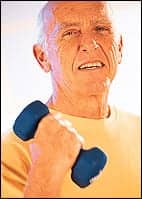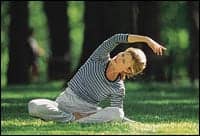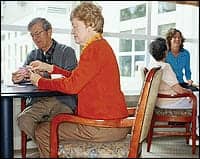 |
It is no secret that the number of older adults in the United States is on the rise. Today, one in every eight Americans is age 65 or older—a number anticipated to jump 51% by 2020 as Baby Boomers attain senior status.1 Americans are also living longer. Today, US residents have a life expectancy of 77.9 years, and the number of Americans age 85 and older will increase 40% by the end of the decade.1,2
In a society obsessed with youth, older adults often have been marginalized, but the increasing senior population is fostering positive awareness about the need to support older Americans. These increases also pose serious questions about the country’s already burdened health care system, which may not be able to keep up with the needs of Baby Boomers. The imperative for older adults to maintain functional independence is greater than ever, and PTs play a critical role in helping seniors regain lost functionality by addressing both the physical and the emotional aspects of aging.
MOTIVATING FACTORS
No one wants functional independence more than seniors themselves. “The greatest fear adults have has to do with losing independence,” says Laura Mosqueda, MD, FAAFP, AGSF, Ronald W. Reagan Endowed Chair in Geriatrics and director of the geriatrics program at UC Irvine Medical Center. “Fear of death isn’t even in the top 10.”
Under the current reimbursement structure, PTs often work with older patients to address a specific disability—perhaps the result of a stroke or a fall—to help them return to preinjury quality of life. Setting attainable goals for older adults is crucial. “Provide them with activities that have a high success rate so that they can actually experience success,” says Debra Rose, PhD, professor in kinesiology and codirector of the Center for Successful Aging at California State University, Fullerton. “That gives them more motivation to continue.”
Involving patients in their own treatment also can go a long way toward motivation. This means asking patients about their personal goals and listening very carefully to their concerns. “It’s really important for patients to know that they’re cared about,” Mosqueda says. “The relationship that a patient has with his or her physician, nurse, or PT will then help drive issues such as motivation, compliance, and follow-through.”
Sometimes, goals must be negotiated between patients and PTs. For example, accepting an assistive device, such as a cane or a walker, can be an emotional hurdle for older adults, who may be afraid that the device carries a stigma. PTs should discuss these fears with their patients and make sure to listen for any misconceptions. “One of the common ones is, ‘If I use a walker, I’m going to be in a wheelchair in 6 months,’ ” Mosqueda says. “If you know that, then you can address it.”
Instead of dwelling on fall prevention, PTs should focus on the mobility and safety benefits of assistive devices to demonstrate the improved quality of life they offer to patients. Older adults also need to be matched to the device that works best for them. In some cases, this may mean a nontraditional alternative, such as walking poles, which offer some seniors the assistance they need without the social stigma. “We’ve found those to be really successful in situations where older adults are resistant to beginning to use assistive devices,” Rose says.
OPENING COMMUNICATION
When working with older adults, PTs must remember to enunciate clearly and maintain eye contact so that patients do not miss important instructions. “Some people are very hard of hearing, and it’s not an issue of speaking louder in all cases—just mouthing the words so they can see you,” says Lora Bronson, MS, a Long Beach, Calif-based gerontology consultant. Bronson also recommends delivering information in more than one way—for example, a written handout often reinforces verbal instructions.
It also is important to look for underlying causes to the patient’s disability. “We can treat the physical problem, but if we don’t address what’s promoting the physical problem or how they can maintain involvement in the activities, then it’s going to be for naught,” Rose says.
 |
| By pursuing activities that stimulate both mind and body, a person can remain healthy and alert for a lifetime. |
The best solution is an interdisciplinary approach involving close communication with the patient’s physicians and caregivers. PTs can be instrumental in facilitating communication between patients and their primary care physicians—for example, suggesting questions for older adults to ask their physicians, or even reminding patients to keep physicians apprised of their medications. An interdisciplinary approach may help patients head off a sentinel event, such as a fall. “Often, what transpires before the fall is a lot of functional change that could be addressed early if we took a multifactorial approach,” Rose says.
Sometimes, emotional distress, including fear or depression, can be a major obstacle to regaining functionality. To ensure successful outcomes for patients, PTs must be aware of the patient’s emotional needs as well. Laura Trejo, MSG, MPA, general manager of the Department of Aging in Los Angeles, recommends that all PTs understand basic screening instruments for depression.
“If someone is very clinically depressed and not being treated, it’s going to be a lot harder for them to benefit from or even follow through on the recommendations made by the PT,” she says.
Depression and other types of emotional distress can be detected through verbal and physical cues. “There will be lots of physical manifestations of increasing emotional stress,” Rose says. “Patients may be less attentive or even be resistant to doing certain things because they feel hopeless.”
PTs also are in a unique position to detect signs of abuse and neglect. Nearly 2% of older adults are victims of elder abuse, according to Mosqueda. “It’s become pretty clear that what makes you more vulnerable to being a victim of abuse as you get older is functional decline,” she says.
MOVING FORWARD
The current health care model focuses on problem-specific solutions rather than preventive care. As a result, PTs often have only a limited time with patients. Many communities provide resources to support older adults after physical therapy is complete. For example, Trejo’s department recently launched the Active Start Program, a national demonstration project that offers a peer-led exercise program to seniors with limited physical ability. “Imagine seeing a 70-year-old great-grandmother teaching an exercise class, who 6 or 7 months ago was really having a hard time walking,” Trejo says. “Who better to tell you the benefits of engaging in mobility than someone who has experienced that firsthand?”
Proactive adults incorporate regular exercise and social interactions into their routines, but finding ways to stay active does not have to be a chore. “A big part of being involved in physical activity over the long term is being involved in activities that you enjoy,” Rose says.
 |
| Playing games such as bridge or Sudoku can help sustain an individual’s cognitive function. |
Rose recommends that older adults sprinkle spontaneous physical and social activities throughout the day. This could be as simple as going for a walk with a friend, playing games such as Sudoku or bridge that involve problem-solving skills that can help sustain cognitive function, and taking advantage of classes in dancing, aerobics, and Tai Chi through local colleges or community programs.
While the influx of aging Baby Boomers may pose a threat to the current health care system, they are also becoming more savvy about healthy aging. While there are worries that many in this generation are not saving for retirement, the Baby Boomers currently control 80% of the nation’s financial assets,3 which means that we can expect to see more goods and services marketed specifically to their needs. Even the depiction of older adults in the media is changing. Bronson notes that older actresses such as Diane Keaton, who recently turned 60, are featured in advertisements for cosmetics—a recent development in a youth-centered industry.
Attitudes toward older adults are slowly beginning to shift, but there are still many stigmas to overcome. “We have a big fear of aging in our society, and I think as a result, we’re fairly ageist,” Mosqueda says. “We [need to] move more toward a kind of loving, embracing approach for older adults who might be quite dependent because we’re going to say these people are still valuable and important to us.”
As the general public becomes more aware of issues facing seniors, the hope is that people will take the necessary steps to maintain independence in every aspect of their lives. “I hope people can be really proactive about taking care of themselves,” Bronson says, “preparing for the future financially, physically, and mentally.”
Ann H. Carlson is a contributing writer for Rehab Management. For more information, contact
REFERENCES
- Administration on Aging. A profile of older Americans: 2006. Department of Health and Human Services. Available at: [removed]www.aoa.gov/press/did_you_know/2007/march/2006profile.pdf[/removed]. Accessed April 19, 2007.
- National Center for Health Statistics. Life expectancy. Fast stats A to Z. Centers for Disease Control and Prevention. Available at: www.cdc.gov/nchs/fastats/lifexpec.htm. Accessed April 19, 2007.
- Cummings EM. When gray equals green. CMO Magazine. January 2005;24-31.
Know Your Resources
Directing patients to community services designed for older adults can help them maintain the functionality they worked so hard to achieve during physical therapy. To find these resources in your area, consider contacting the following organizations:
- Area agencies on aging: More than 600 departments of aging are based in communities across the country. These agencies offer many resources for seniors, from physical mobility classes to in-home food delivery to transportation services. For the department nearest you, visit [removed]www.aoa.gov/edfam/How_To_Find/Agencies/Agencies.asp[/removed]
- Community colleges: Local colleges offer a variety of courses specifically for seniors who want to pursue art, dance, or Tai Chi, or even attend seminars on financial planning or starting a second career. Older adults may prefer college campuses to traditional senior centers. In fact, some community colleges are moving away from using the term “senior” in their curriculum to attract Baby Boomers, who may not otherwise attend. To find a community college near you, visit [removed]www.aacc.nche.edu/Content/NavigationMenu/AboutCommunityColleges…[/removed]
- Home-assessment organizations: For seniors who either do not qualify for or cannot afford a professional home assessment, volunteers from organizations such as Rebuilding Together, Washington, DC, offer advice on how to make homes safe and comfortable for older adults. For more information, visit www.rebuildingtogether.org
- Naturally occurring retirement communities: There is a national effort to study neighborhoods where older adults compose a large percentage of the population. These communities give service providers an opportunity to explore what types of support seniors need and how to bring those services directly to the community. It also allows older adults to be role models and resources for other seniors and engage in civic aid and volunteerism. For more information about these communities, visit www.seniorresource.com/ageinpl.htm
—Ann H. Carlson





